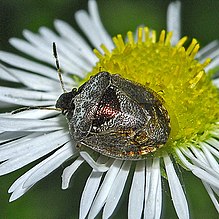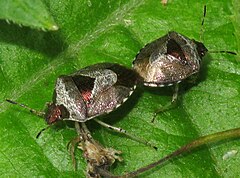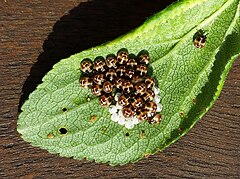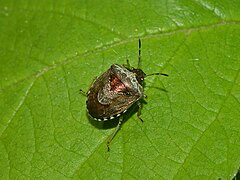| Stagonomus venustissimus | |
|---|---|

| |
| Adult of Stagonomus venustissimus | |
| Scientific classification | |
| Kingdom: | Animalia |
| Phylum: | Arthropoda |
| Class: | Insecta |
| Order: | Hemiptera |
| Suborder: | Heteroptera |
| Infraorder: | Pentatomomorpha |
| Superfamily: | Pentatomoidea |
| Family: | Pentatomidae |
| Subfamily: | Pentatominae |
| Genus: | Stagonomus |
| Species: | S. venustissimus |
| Binomial name | |
| Stagonomus venustissimus (Schrank, 1776) | |
| Synonyms | |
List
| |
Stagonomus venustissimus, common name woundwort shieldbug, is a species of shieldbug belonging to the family Pentatomidae, subfamily Pentatominae.
Scientific name
The species was first named by Fabricius as Cimex melanocephalus. However this name had already been used by Linnaeus for the mirid bug now known as Phylus melanocephalus - at the time, the genus Cimex encompassed the entirety of the Heteroptera.
The replacement name Eysarcoris fabricii given by Kirkaldy in 1904 was used for many years, but Rider (1998) pointed out the seniority of the name venustissimus, given by Schrank in 1776 (Schönste Wanze, most beautiful bug).
This species has been recently transferred to the genus Stagonomus, so the correct name is Stagonomus venustissimus (Schrank, 1776).
Distribution
This species can be found in most of Europe.
Description
Stagonomus venustissimus can reach a length of 5–7 millimetres (0.20–0.28 in). These small bugs have a greenish-grey body. The head and the pronotum are copper coloured. They have a bronze-purple triangular stain at the base of the scutellum. The connexivum has black and white markings. The legs are whitish with black spots
Biology
Stagonomus venustissimus is a univoltine species. The larvae are visible from late June to October, while the new generation of adults appear from August through the following July.
The nymphs feed on hedge woundwort (Stachys sylvatica), particularly the seeds, and on Lamiaceae species, especially on white dead-nettle (Lamium album).
Gallery
References
- Io. Christ. Fabricius (1775). Systema entomologiae: sistens insectorum classes, ordines, genera, species, adiectis synonymis, locis, descriptionibus, observationibus. Flensburg et Lipsiae (Leipzig). pp. 716-717.
- D. A. Rider (1998). "Nomenclatural changes in the Pentatomoidea (Hemiptera-Heteroptera: Cydnidae, Pentatomidae). II. Species level changes" (PDF). Proceedings of the Washington Entomological Society. 100 (3). p. 453.
- Franciscus de Paula Schrank (1781). Enumeratio insectorum Austriae indigenorum. Augusta Vindelicorum (Augsburg). p. 277.
- Roca-Cusachs M. & Jung S. 2019. Redefining Stagonomus Gorski based on morphological and molecular data (Pentatomidae: Eysarcorini). Zootaxa 4658(2): 368-374
- Fauna europaea
- D. A. Rider (2006). "Pentatomidae". In Aukema B, Rieger C (eds.). Catalogue of the Heteroptera of the Palaearctic Region, vol. 5: Pentatomomorpha II. Amsterdam: Netherlands Entomological Society. ISBN 9789071912283.
- ^ British Bugs
- Nature Network Amiens
External links
| Taxon identifiers | |
|---|---|
| Eysarcoris venustissimus | |



